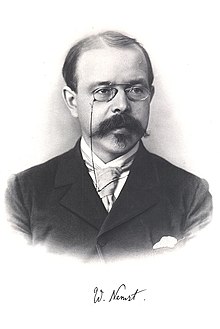Walther Nernst
Walther Nernst | |
|---|---|
 Walther Hermann Nernst (1864-1941) | |
| Born | June 25, 1864 |
| Died | November 18, 1941 (aged 77) |
| Nationality | |
| Alma mater | University of Zürich University of Berlin University of Graz University of Wurzburg |
| Known for | Work on electrolytes |
| Awards | |
| Scientific career | |
| Fields | Physicist |
| Institutions | University of Göttingen University of Berlin |
| Doctoral advisor | Friedrich Kohlrausch |
| Doctoral students | Sir Frances Simon, Richard Abegg, Irving Langmuir |
Walther Hermann Nernst (June 25, 1864 – November 18, 1941) was a German chemist who is known for his theories behind the calculation of chemical affinity as embodied in the third law of thermodynamics, for which he won the 1920 Nobel Prize in chemistry. Nernst helped establish the modern field of physical chemistry and contributed to electrochemistry, thermodynamics, solid state chemistry and photochemistry. He is also known for developing the Nernst equation.
Biography
Nernst was born in Briesen in West Prussia (now Wąbrzeźno in Poland) to a German father and a Polish mother. He studied physics and mathematics at the universities of Zürich, Berlin and Graz. After some work at Leipzig, he founded the Institute of Physical Chemistry and Electrochemistry at Göttingen. Nernst invented, in 1897, the Nernst lamp, an electric lamp using an incandescent ceramic rod (the successor to the carbon lamp and the precursor to the incandescent lamp). Nernst researched osmotic pressure and electrochemistry. In 1905, he established what he referred to as his "New Heat Theorem", later known as the Third law of thermodynamics (which describes the behavior of matter as temperatures approach absolute zero).
In 1920, he received the Nobel Prize in chemistry in recognition of his work in thermochemistry. In 1924, he became director of the Institute of Physical Chemistry at Berlin, a position from which he retired in 1933. Nernst went on to work in electroacoustics and astrophysics.
Nernst developed an electric piano, the "Neo-Bechstein-Flügel" in 1930 in association with the Bechstein and Siemens companies, replacing the sounding board with radio amplifiers. The piano used electromagnetic pickups to produce electronically modified and amplified sound in the same way as an electric guitar.
His Nernst glower, important in the field of infra-red spectroscopy, is a solid-body radiator with a filament of rare-earth oxides. Continuous ohmic heating of the filament results in conduction. The glower operates best in wavelengths from 2 to 14 micrometers.
Nernst died in 1941 and is buried near Max Planck in Göttingen, Germany.
Publications
- Walther Nernst, "Reasoning of theoretical chemistry: Nine papers (1889-1921)" (Ger., Begründung der Theoretischen Chemie : Neun Abhandlungen, 1889-1921). Frankfurt am Main : Verlag Harri Deutsch, c. 2003. ISBN 3-8171-3290-5
- Walther Nernst, "The theoretical and experimental bases of the New Heat Theorem" (Ger., Die theoretischen und experimentellen Grundlagen des neuen Wärmesatzes). Halle [Ger.] W. Knapp, 1918 [tr. 1926]. [ed., this is a list of thermodynamical papers from the physico-chemical institute of the University of Berlin (1906-1916); Translation available by Guy Barr (LCCN 27002575)])
- Walther Nernst, "Theoretical chemistry from the standpoint of Avogadro's rule and thermodynamics" (Ger., Theoretische Chemie vom Standpunkte der Avogadroschen Regel und der Thermodynamik). Stuttgart, F. Enke, 1893 [5th edition, 1923]. LCCN po 28000417
Further reading
- Mendelssohn, Kurt A. G., "The world of Walther Nernst. The rise and fall of German science.". Macmillan, 1973 (biography).
- Barkan, Diana Kormos, "Walther Nernst and the Transition to Modern Physical Science". Cambridge University Press, 1998.
External links and references
- Katz, Eugenii, "Hermann Walther Nernst". Biographies of Famous Electrochemists and Physicists Contributed to Understanding of Electricity.
- "Hermann Walther Nernst, Nobel Prize in Chemistry 1920 : Prize Presentation". Presentation Speech by Professor Gerard de Geer, President of the Royal Swedish Academy of Sciences.
- Schmitt, Ulrich, "Walther Nernst". Physicochemical institute, Göttingen
- "Nernst: architect of physical revolution". Physics World, September 1999.
- Suhling, Lothar, "Walther Nernst and the ammonia synthesis after Haber and Bosch". ISBN 3-928186-15-9
- recognition of his work in thermochemistry

